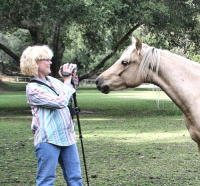 In this wonderful age of technology, you no longer need fancy camera equipment to get that Award-Winning photo of your horse. Â The camera on your smartphone, some time in practicing and a little luck in being camera-in-hand at the right moment will do it. Â Â Start with 100 pics each session and you should have 1 spectacular one. Â As you practice, you will end up with 2 good ones, then 3 and so on.
In this wonderful age of technology, you no longer need fancy camera equipment to get that Award-Winning photo of your horse. Â The camera on your smartphone, some time in practicing and a little luck in being camera-in-hand at the right moment will do it. Â Â Start with 100 pics each session and you should have 1 spectacular one. Â As you practice, you will end up with 2 good ones, then 3 and so on.
Here are some tips that I have learned in my 18+ years of studio work that you can practice with:
1. Consider your composition and place your subject ‘off-center’. It is often said that an artist spends more time planning where they want the viewer’s eye to travel – than actually painting. It’s the same with photography. This careful thought into the composition (where items/subjects rest in the real estate of your picture) determines if the viewer’s eye is going to hang out for awhile and be entertained…or if it’s going to see 1 point of interest and leave.
Placing your subject slightly off-center with enticing paths in the background for the eyes to follow will keep the viewer looking at your image. Try colorful objects, figures, fences, roads, horizons, mountaintops, tree-lines, shorelines, footsteps in the sand, etc.   Then bring the eye back to your main subject. Look at a pic now and pay attention to where your eye ball moves. See what I mean?
2. Â Thanks to the Delete button, we have lots of new creative powers. Â Use the ‘action’ or ‘sports’ multi-shutter setting on your camera. Â Then pick the best one and delete the rest. Â This is wonderful for getting that perfect leg position or the best wind-blown mane. Â Even with still shots, if the horse flinches, you should have a good one before or after the flinch.
3. Â The subject should be at least 75% of the image and the background 25% for head, shoulders or body shots. Â For Scenic shots, the horse should be at least 25% of the image.
4.  The best times to shoot are in the late afternoon when the shadows are long.  Or early in the morning when the light is brightest and warmest in color and the shadows are still long.  Never shoot at high noon.  The 2D camera will have no contrast to work with and your images will be flat.
5. Â Subject in the sun. Â You in the shade. Â This will prevent any light from hitting the lens and causing distortions, blurring and faulty colors.
6. Â Windy days can make dramatic shots. Â The flowing mane and landscaping will bring ‘action’ to still subjects.
7. Â Notice the color of the background. Â White horse/grey barn…not good. Â White horse/green trees..beautiful contrast. Â Sometimes just taking a step or twisting left or right will change your background from crappy to gorgeous!
8.  Ears forward for portrait shots.  Use a treat or a reactionary command if needed.
9.  No posing – you or the horse.  When the brain sees a pic, it knows the body isn’t there, so the emotion is one of voyeurism or being a ‘peeping Tom’.  Making up a story is it’s first reaction, so it knows how to file and prioritize the data the eyes are logging.  If the subjects are posed, then the brain tells the eyes to move on…there is no story here that I can create.
10. Â Don’t over-filter…either pre-shot or post-shot. Â Pre-shot is with your camera settings/apps and Post-shot is with your editing software/apps. Â It’s obvious and unattractive. Â Just take a new shot.
11. Â An intimate subject/moment calls for intimate framing. Â Don’t be afraid to pull the viewer in by zooming in a little bit more. Â On the other hand…
12.  Is it micro-photo art or did you zoom in a bit too much?  There is no expression in the eyeball itself.  If you are fascinated by the mirror images that reflect in your horses eye when you get really close, then you WILL need the special micro lenses and equipment that make that image work.  Close-up portraiture needs the horses natural means of communicating emotion to  create that story for the viewer – i.e., head tilt, eye lids, ear postions, mouth/lip/tongue movements, clear focus and lighting.  And/or an intimate moment with another subject or object – like a wind-blown piece of mane, a leafy branch, a worn and story-filled bridle, etc.
Mute your phone and go create! Â Your horse will love the attention and your brain will love the exercise.
Bj. deCastro

